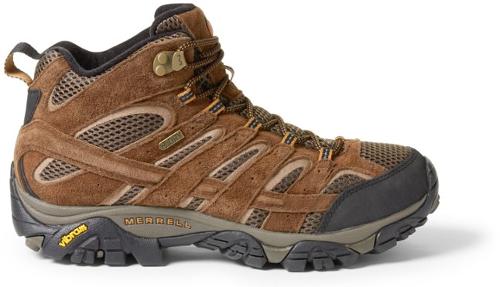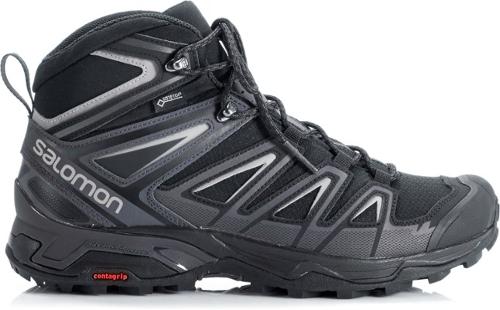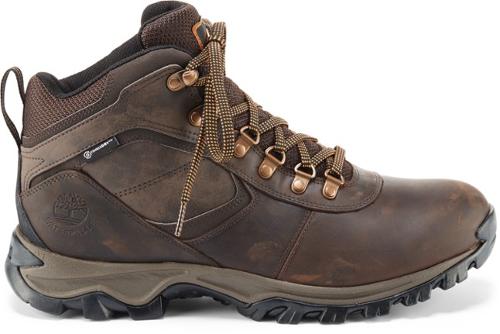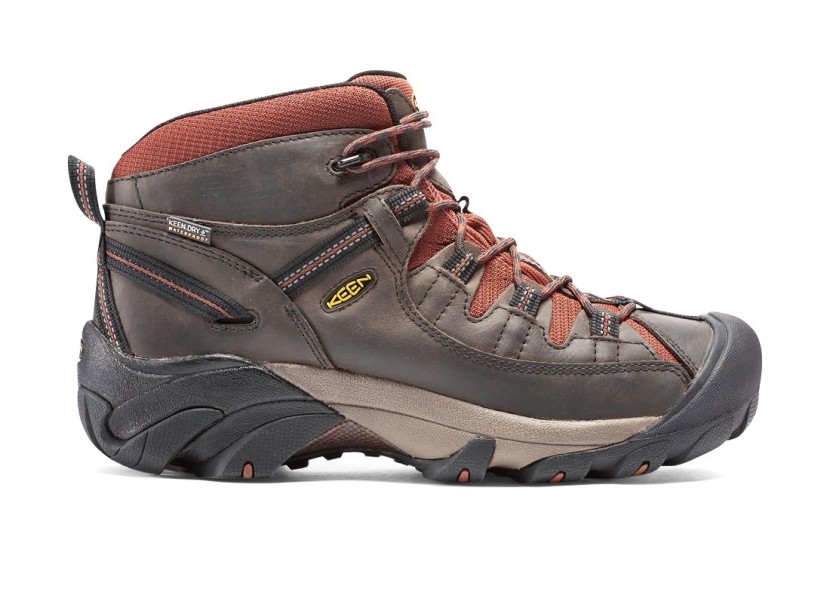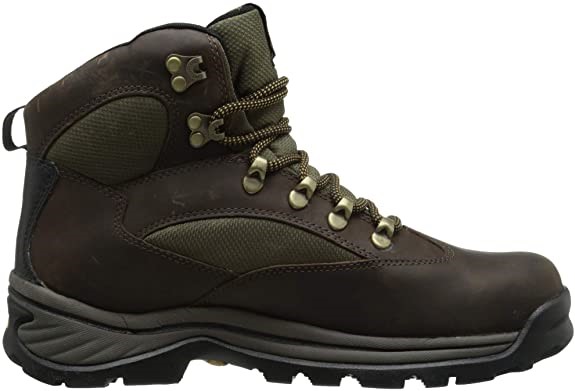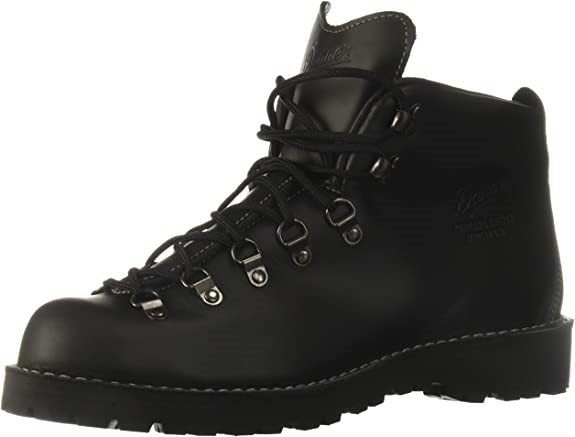Hikers with wide feet are common. As a result, many of the best hiking boots and hiking shoes may be too snug, especially as your feet begin to swell.
Perhaps you're one of the many people looking for a new pair of hiking boots, but you're continually tearing your hair out in what appears to be a fruitless search for the best hiking boots.
But you don’t have to worry anymore, in this article we will be talking about the top 7 best hiking & backpacking boots for wide feet for men's and women's.
let's get started!
Disclosure: Hikers Needs is reader-supported. Buying through links on our site may earn us an affiliate commission.
Quick answer:
BEST backpacking BOOTS FOR WIDE FEET
Check out this quick list of our favorite Boots for Wide Feet if you’re in a hurry, or continue scrolling to see our full list with in-depth reviews
1-Merrell Moab 2 Mid
2-SALOMON X ULTRA 3
3-Timberland Earthkeepers Mt. Maddsen
4-Danner Mountain 600
5-Keen Targhee II
6-Timberland Chocorua Trail Boots
7-Danner Mountain Light
Best hiking Boots for Wide Feet
1- Merrell Moab 2 Mid
The MOAB 2 from Merrell is the "classic" model in the hiking boot market, however it is far from the be-all and end-all boot.
Unlike many other types of leather uppers, the mix of mesh and nubuck leather in the upper (also known as buffed-leather suede) enables this boot achieve optimum toughness without compromising too much ventilation.
This boot provide very good fitting for wide feet and excellent traction , thanks to the 5mm Vibram rubber outsole lugs, which provide improved grip without adding the extra weight that deeper treads do.
Nubuck leather, like other common boot materials, takes longer to break in than other materials, and the MOAB 2 is no different, MOAB 2’s air-cushioned heel, contoured footbed and foam tongue are one of the most comfortable and durable hiking boots on the market.
Most importantly, MOAB 2 offers wide-format models suitable for all sizes and colors.
Pros:
Cons:
Reason to get this: Best OVERALL COMFORT
2- SALOMON X ULTRA 3
The Salomon X Ultra 3 is the latest iteration of Salomon's X Ultra hiking boot line, which has improved greatly over previous models.
This hiking boot is ideal for anyone seeking for a wide-fitting, long-distance hiking boots. It earns this recognition thanks to its Gore-Tex wrapping, which provides excellent breathability and waterproofing, as well as a dual-rubber outsole that provides excellent flexibility and toughness.
Additionally, the sophisticated external chassis of the X Ultra 3 provides unwavering support by covering the whole boot in a sturdy frame that forms a strong foundation for the foot.
The best part is that the X Ultra 3 not only has a stylish design than its predecessors, but it also costs less, making it an excellent choice for hikers of all capabilities.
Pros:
Cons:
Reason to get this: best for LONG DISTANCE
3-Timberland Earthkeepers Mt. Maddsen
The Timberland's Earthkeeper Mt. Maddsen should be on the top of your list if you're seeking for a boot that will fit your broad feet and won't break the budget. The full-grain leather uppers provide extreme toughness and waterproofing to this boot.
The flexible yet durable thermoplastic polyurethane (TPU) shanks provide excellent arch support while being lightweight and dependable.
Finally, debris-blocking tongues keep your feet safe from rocks and other irritants that tend to infect boots like a virus.
Overall, this boot outperforms the competition in terms of meeting all of the essential features of a hiking boot while being under the average price. The Earthkeeper Mt. Maddsen is a long-lasting, comfortable backpacking boots.
Pros:
Cons:
Reason to get this: Best For Value
4-Danner Mountain 600
For men and women with wider feet, the Danner Mountain offers a lightweight alternative. Their hiking boots 600 is relatively light. It is entirely waterproof and can withstand rain, snow, and muck. Its internal waterproof liner and water-resistant nubuck help to achieve this. These boots' underfoot is highly flexible and provides a great deal of comfort. The upper is made entirely of suede.
The lacing is of good quality and will not rust. When you wear these boots, you won't have to worry about your feet being cold. There is also plenty of room to breathe. These hiking boots are ideal for short hikes or day trips.
These boots' Mega-grip technology allows them to preserve their footing while delivering a lot of traction. The Vibram SPE midsole also provides plenty of comfort and support.
Pros:
Cons:
Reason to get this: Best For Shorter Hikes
5- Keen Targhee II
The Keens Targhee II hiking boots for wide feet have a 100 % waterproof Nubuck leather fabric that provides them unbeatable toughness and four-wheel-drive efficiency in even the roughest and rainy environments.
The thick rubber outsoles combine the leather upper to keep everything out, whether you're attempting to tackle Denali, hiking on rainy treks, or camping on lonely roads.
The extra wide hiking boots' waterproof top layer, on the other hand, has breathable mesh that allows for excellent moisture wicking, keeping your feet dry, fresh, and comfy.
On the other hand, the tight compression straps on the heel keep it secure with each step. On the other hand, the strong lug design improves gripping
Pros:
Cons:
Reason to get this: Best All-Weather Wide Hiking Boots
6- Timberland Chocorua Trail Boots
The Timberland Chocorua Trail Boots offer a well recommended, waterproof option that’s great for hikers with wide feet.
Constructed with waterproof leather, mesh uppers for breathability, and rubber soles, these boots are an excellent choice. The lacing system is also rustproof, and an EVA foam midsole provides shock absorption.
Timberland has a limited warranty for its products in case of potential defects or problems.
For the environmentally conscious, the fabric lining of the boots and the waterproof membrane contain construction materials sourced from at least 50% recycled water bottles.
Timberland says the leather is sourced from a tannery known and rated for proper water, energy, and waste management practices.
Pros:
Cons:
7- Danner Mountain Light
The Danner Mountain Light only comes in wide sizes. It was built on a traditionally narrow last, so to combat this, it is only sold in EE/Wide.
Danner boots run on the expensive side, but with several styles and fits, reconstruction availability, and amazing construction, it’s hard to beat them.
I recommend the Mountain Light boots because they only run wide, so people with wide feet often have good luck with the fit.
Danner recommends that people generally downsize by half a size to get the best fit, but users with wider feet have noted that they can often use their regular Brannock device shoe size and get a great fit.
While I always recommend trying on boots, these may be an easy choice that works for wide feet.
With a craftable sole, GORE-TEX liners, durable full-grain leather, and iconic old-school style, these boots quickly became a favorite of mine.
While the price is steep, if you can snag a pair on sale it’s well worth it!
Pros:
Cons:
How To Choose Hiking Boots For Wide Feet
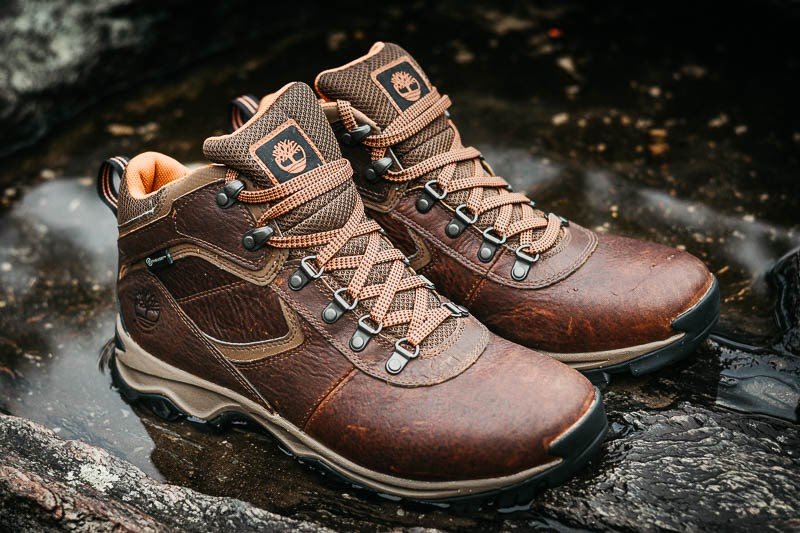
When it comes to choosing a pair of boots for you, forget about appearance, numerical sizes, stylish features, or even what your friends recommend–unless their feet are identical to yours. The main things you should consider are comfort, durability, stability, weight, warmth, and water resistance.
The main thing in buying boots is to get a solid match, with a cozy fit at the heel and squirming space for your toes in front. Many brands run a bit wider, and trying on boots from a brand that is known to run wide can make the process a bit less painful.
A few companies that produce generally wider hiking boots are Merrell, Keen, Timberland, and some models of Danner boots. I have a pair of Danner Mountain boots, and they recommend that most people size down since they run a bit wide.
If you have a wider foot, boots like that may fit you more comfortably than a brand that tends to run narrow. Another thing to consider beforehand is what time of day you had your foot measured, or tried on a boot.
When you spend a day walking, your feet swell. Sometimes your feet may swell to a noticeable degree, and if you have wide feet that are already having trouble in your new pair of boots, this may make them unbearable to wear.
I recommend measuring your feet or trying on hiking/backpacking boots late in the day to at least slightly account for potential swelling. Your feet also tend to swell as you get older and/or put on weight.
FIT
The greatest wide width hiking boots, like any other boot, are made to fit you according to your boot size. They are, however, built specifically for people who have broader feet and would otherwise feel uncomfortable wearing ordinary shoes of the same size.
For example, if your boot size is a 12 but you have wider feet, you should order a size 12 W to ensure a proper fit that doesn't squeeze your feet on the sides.
Women's and men's sizes are created for hiking boots for broad foot, as their form is also developed for the target gender. A size 10W for men, for example, will not always fit a woman's shoe size of 10W.
WEIGHT
Before choosing a hiking boots for your wide feet, think about the distance you want to cover with your new footwear. As a result, it's critical that you pay attention to the weight of the boots you're looking into buying. It is best to use a lightweight boot on a long-distance trip.
Remember, though, that a boot that is excessively light may compromise your step's stability. The average weight of hiking boots is between 2 34 and 3 14 pounds, but many manufacturers make lightweight boots for use over longer distances.
As a result, think about the distance and terrain you'll be covering with your new boots to discover the best fit.
As a result, think about the distance and terrain you'll be covering with your hiking boots to discover the best mix of comfort and control.
TREAD
best wide hiking boots have a solid construction and flexible lug depth and layouts that make traversing the terrain much more comfy.
The rubber bump designs on the outsoles are called lugs, and they're designed to improve traction and make walking on various terrains easier.
The outsole material has an impact on both weight and toughness, as some types of rubber are better suited to exceptionally rough or uneven terrain than others.
Recycled rubbers will never be as durable as Vibram, but Vibram will almost certainly weigh more than a recycled rubber; it's all about striking that delicate balance.
COST
While it may not appear to be a huge investment, but price is an important factor to consider when selecting a hiking boots. Although there are plenty of other factors that influence the pricing.
You'll pay a lot more for anything that's primarily composed of leather. Hiking boots that cost extra, like most other purchases, usually do so for a purpose.
They are more likely to endure longer or have more desirable traits. Before you spend any of your hard-earned money, think about this.
VENTILATION
When it comes to making comfortable hiking boots for wide feet, ventilation is essential. If your boots are well-protected to provide complete waterproofness and insulation, chances are they will have limited ventilation.
Material like Gore-tex, on the other hand, is cleverly developed to provide extreme waterproofness while preserving perfect airflow. Breathable hiking boots not only keep your feet dry and fresh, but they also protect them from microbial or fungal growth and keep them organic.
COMFORT
The comfort of a hiking boot is important, as it is with basically any form of shoes. Whether you're going on a short hike or extended trip, you'll want to be sure you have a boot that won't bother or blister your feet.
This can also be helped with more sophisticated socks, but it's still necessary to think about how much padded support your new boots will provide.
FAQs
How can I tell if my boots aren’t wide enough?
Determining the correct sizing for footwear can be tricky. To check if your backpacking boots are wide enough for your feet, first lace them up properly.
Like any footwear, you’ll often be able to grasp if they fit correctly by trying them on and walking a bit.
Try to watch out for pressure on the sides of your feet and/or toes. It’s also imperative to be on the lookout for if you feel any of your toes overlap.
This can cause blisters on hikes, and if you’re backpacking it’s best to keep your feet in good condition.
I also recommend using a Brannock device to size your feet. Another easy way to check on fit is to remove the insole of a boot and place it on the ground.
You can step on it and see if your foot properly fits it. While you shouldn’t use that as your only metric of sizing, it can be a helpful way to visualize the fit of your boots.
what can i do if my hiking boots are too narrow?
If you’ve already got a pair of hiking boots and they fit a bit narrow, it can be both very concerning, and uncomfortable. The problem with a narrow boot is that few fixes will help them work effectively.
Poor-fitting footwear on the trail generally just leads to discomfort, misery, and a potential factor in ruining your backpacking trip.
I would primarily recommend trading them in for another pair, but if that’s not possible, there are a few things you can do.
To start, there are plenty of lacing techniques that you can do to help relieve pressure in various areas of your feet.
If you research different methods of lacing up your boots, it may loosen your boot or shoe overall or on areas of high pressure, and make them more usable.
Other fixes include wearing thinner pairs of socks and trying thinner aftermarket insoles.
For more related guides read my other posts:
About the Author

Hussain is a passionate hiker and traveler that love the outdoor and enjoys what nature has to give, whenever he can he love to write and give tips & honest reviews to help others get out there and just seek more unforgettable experiences.

